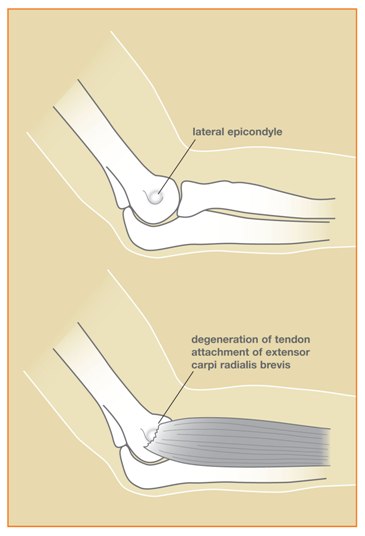Tennis Elbow
What is Tennis Elbow?
Tennis elbow, also known as “lateral epicondylitis,” is a painful and functionally-limiting condition affecting many patients. Tennis elbow is caused by degeneration within the extensor carpi radialis brevis (ECRB) tendon on the outside of the elbow. Despite the name, tennis elbow is not just limited to tennis players. In fact, tennis elbow is commonly diagnosed in patients between the ages of 30 and 50, many of whom have never played tennis.
Patients experience pain on the outside of the elbow and often point to a very tender spot near the lateral epicondyle bony prominence (see image below). Symptoms can be aggravated by a forceful, repetitive activity with the hand and wrist, such as the tennis backhand swing or heavy gripping. Lifting light objects, gripping the steering wheel, and even simple household activities can be painful at times. Fortunately, the majority of patients with tennis elbow improve with non-operative treatment, although symptoms often take several weeks or months to resolve.
Golfer’s elbow, or “medial epicondylitis,” is a similar condition which causes pain on the medial, or inside, of the elbow. Both conditions can be diagnosed in the office based on your symptoms, physical exam, and x-rays. MRI is typically not required to make the diagnosis.

What are the Non-Operative Treatment Options for Tennis Elbow?
- Braces: Wearing a forearm strap or wrist splint
- Activity modification: Resting, avoiding repetitive, heavy lifting or forceful gripping
- Medications: Taking anti-inflammatory medications such as Motrin, Naproxen, or Tylenol
- Stretches: Stretching the muscles of the hand, wrist, and elbow with exercises
- Hand Therapy: A therapist can guide tennis elbow exercises and perform iontophoresis, ultrasound, or therapy modalities
- Corticosteroid injection: Anti-inflammatory medication injection targeting the degenerative ECRB tissue can reduce pain
- PRP: platelet rich plasma is a newer injection which can be used to improve healing of the degenerative tissue
When is Surgery for Tennis Elbow Recommended?
If non-operative treatment fails to improve the symptoms to a satisfactory degree after several months of conservative treatment, surgery may be recommended. During the outpatient surgery, a small portion of degenerative ECRB tissue is removed or “debrided.” This procedure is thought to stimulate healing of the normal surrounding tissues while removing the painful degenerative tissue. The type and length of incision varies among surgeons. This surgery is not a “quick fix” since returning to sports, heavy work, or weight training can take 3-6 months and additional therapy.
What are the Expected Results from Tennis Elbow Surgery?
Most patients experience a significant reduction in pain, report improved function, and are satisfied with their outcome after tennis elbow surgery. However, not all patients experience complete pain relief.
What Are the Potential Complications from Surgery for Tennis Elbow?
No surgery is risk-free. However, major complications from tennis elbow surgery are uncommon. Possible complications include persistent pain, infection, stiffness, and nerve injury.
Eliminate Tennis Elbow Pain and Get Back in the Game
Tennis elbow can be a persistent and frustrating condition. At Raleigh Hand to Shoulder Center, our specialized treatments by our Raleigh orthopedic surgeons are designed to relieve pain and help you regain strength in your elbow.
Don’t let tennis elbow hold you back from your favorite activities. Take the first step towards recovery today, and get back on the court in no time.
Get started today by filling out the form on the right-hand side of this page. You can also give us a call directly using the phone call button and schedule an appointment button, both located at the top of this page.
The image and video are provided by the American Society for Surgery of the Hand.


